1998

PROJIMO timeline:
B.
|
The ending of PROJIMO in Ajoya (1997
® 2002)
|
| |
AJOYA |
COYOTITAN |
|
1998 |
 |
Book: "Nothing about us without us." |
|
| |
 |
Newsletter from the Sierra Madre #37 May
 |
Accessible bus ramp constructed in Ajoya
|
|
 |
Newsletter from the Sierra Madre #38 September
 |
March 3-8 1998: training seminar for 'mediators' of
Stichting Liliane Fonds (Ndl.) with 60+ participants. |
|
 |
Newsletter from the Sierra Madre #39 December
 |
Ajoya: PROJIMO Skills Training and Work Program. |
|
 |
"Brot fur die Welt" funding presentation |
|
Construction starts at the new
Coyotitan location |

Visitors:




Nothing about us without us
This publication is available online:
Nothing About Us Without Us
en español:
Nada Sobre Nosotros Sin Nosotros

| From the introduction: |
|

PROJIMO
Most of the innovations explored on these pages were created in
PROJIMO: Program of Rehabilitation Organized by Disabled Youth of
Western Mexico. This small community-oriented program is based in Ajoya,
a village of 1000 inhabitants in the mountains of Western Mexico. .../...

How PROJIMO Differs from Many CBR Programs
PROJIMO - the program in Mexico run by disabled villagers where most of
the innovations in this book come from - differs from many Community Based
Rehabilitation (CBR) programs in that:
 | PROJIMO was started by, and is organized and run by disabled
villagers. |
 | It grew out of and is linked to a villager-run primary health care
program. |
 | The program includes a village-based rehabilitation center where
disabled persons and family members can learn skills, take part in the
creation of assistive equipment, and help and learn from each other. |
 | Services are provided, and assistive equipment is made by disabled
persons who learn their skills mainly through apprenticeship, from one
another and from volunteer rehabilitation professionals and skilled
technicians.
(These "experts" are asked to devote their short visits to teaching skills
rather than providing services.) |
 | The quality and thought that goes into this work has developed beyond
what you find in many community programs - because the PROJIMO workers
have had years of challenging interchange with exceptional leaders in
different fields of disability. Indeed, aids and equipment designed for
and with disabled individuals sometimes meet their specific needs more
effectively than those provided by large urban rehabilitation centers, and
at a much lower cost. |
PROJIMO'S Need for Creative Problem Solving
Since its beginning, PROJIMO has been fairly innovative, not only
technically but in its overall organization and structure. The disabled
workers take pride in running their program on their own terms and in
experimenting with participatory models of decision-making, management, and
funding. In each of these areas they have had striking successes and
failures. The program has evolved through a series of productive crises, the
worst of which have threatened to destroy the program. But each crisis
somehow forces the team to re-evaluate its methods and to experiment with
alternative approaches, which at times prove to be major steps forward.
===============================================================
COMBINING THE BEST OF THE INDEPENDENT LIVING MOVEMENT AND CBR
In recent years, 2 major initiatives have evolved to help meet the needs,
defend the rights, and promote the full integration of disabled people.
These are the Independent Living movement (IL) and Community
Based Rehabilitation (CBR). Active in many countries, both initiatives
are a response to the discrimination, limited opportunities, inadequate
services, and the need for self-determination that most disabled people
experience in the world today.
The two movements have different origins. They also have
different strengths and weaknesses. IL tends to be strong in areas where
CBR is weakest, and CBR strongest in the areas where IL and disabled
people's organizations sometimes are weak.
 | Independent Living: The IL movement was started from the bottom
up by disabled people themselves. It began in the Western industrialized
countries. Through organizations like Disabled People International (DPI),
it has gradually made headway in the so-called developing countries. IL's
biggest strength is social action for equal opportunities, led by
disabled activists. Its biggest weakness is that it is largely a
middle-class movement that often leaves out the poor. Also, living
"independently" (or alone) is a very Western value. In societies with a
strong sense of community, rooted in extended families, living
"inter-dependently" (together) may be a more welcome goal.
|
 | Community Based Rehabilitation: CBR, as an international
initiative, was launched by idealistic rehabilitation experts working with
the World Health Organization (WHO). Its biggest strength is that it
tries to reach all disabled people, especially those who are poorest and
in greatest need. It has an all-inclusive plan, including both
government and private initiatives. But, too often, disabled persons still
are treated as objects to be worked upon, rather than leaders, organizers
and decision makers. |
One of the biggest challenges for disability workers today is to find
ways to link the empowering self-determination of the Independent Living
Movement with the broad outreach to poor people of Community Based
Rehabilitation.
A good place to begin is by encouraging disabled persons to take
over more of the organizational and service-providing roles in CBR programs.
Where possible, disabled people's organizations can lead or advise the
programs (while making an active effort to include the poor and voiceless).
When disabled people learn to design and make assistive equipment, and to
include the user in the process, success is more likely.
|
Community Based Rehabilitation (CBR)
Major STRENGTHS:
Rehab for all! Tries to reach all disabled people, with most
concern for the poor. Comprehensive plan with social focus. Community
education and involvement.
Major WEAKNESSES:
Usually organized for - not by - disabled people. Structure often
top-down. Tends to follow pre-determined recipes, rather than to seek
liberating solutions. |
Disabled Person's Organizations Independent Living
(DPI, etc.)
Major STRENGTHS:
Self-determination! Disabled people take lead in defining their
needs and demanding their rights. Goal is not to normalize disabled
persons, but to stop society's unfairness.
Major WEAKNESSES:
Because members tend to be middle class, the poor are often left out, or
their needs are misinterpreted to fit the priorities of Western
disability activists. |

|
About the PROJIMO Team
|
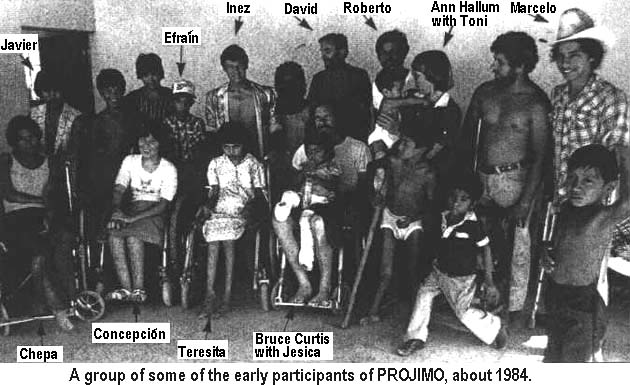 |
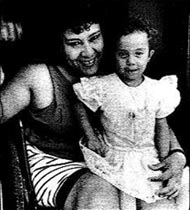 |
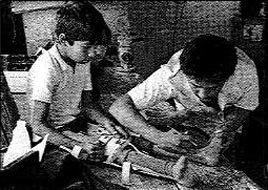 |
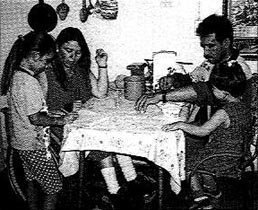 |
| Mari Picos + daughter Lluvia |
??? - Armando Nevérez |
Conchita Lara, Miguel Zamora
+ daughters Camilla + Emily |
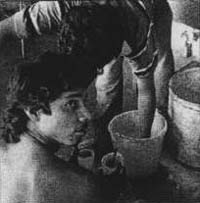 |
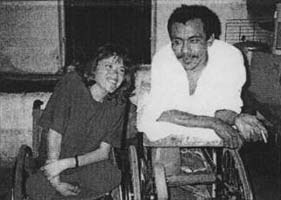 |
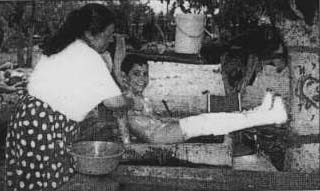 |
| Marcelo Acevedo (†2008) |
Irma Llavió (†...) + Jaime
Torres |
Rosita Salcido + patient |
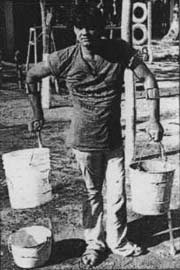 |
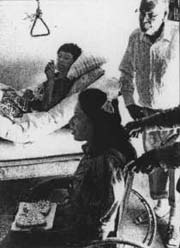 |
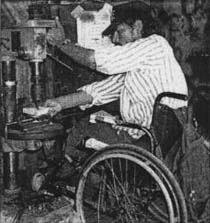 |
| Inez Leon |
Cecilia Rodriguez |
Mario Carrasco |
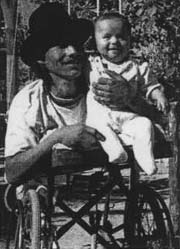 |
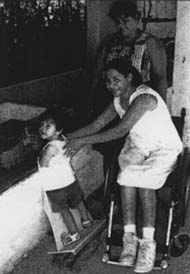 |
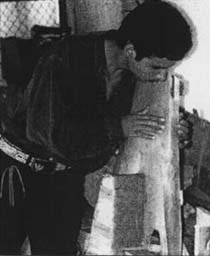 |
| Martín Pérez |
Marielos Rosales, child + parent |
Polo Ribota |
|

Documentation for "Brot für die Welt" funding application.

Page last modified:
October 27, 2011
Return to
PROJIMO home page
Return to my homepage:
www.avemariasongs.org

|
![]()